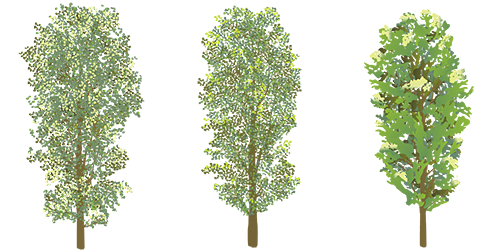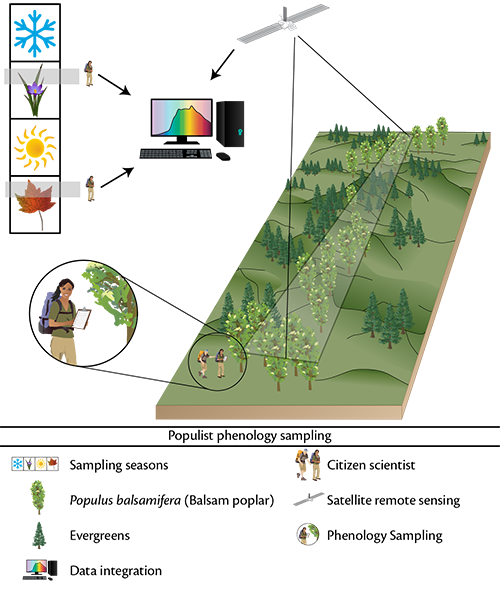Symbols: A universal and effective technique for communication
Bill Dennison ·The use of symbols in the various conceptual diagrams that the Integration and Application Network staff have been employing as part of science communication taps an ancient and effective communication technique. Symbols are universal, transcending cultural and language barriers, as demonstrated by the global adoption of the IAN symbol libraries. I recently experienced two examples of the development and utilization of IAN symbols which shed light on the symbols that we employ.
Firstly, the development of a new symbol for a conceptual diagram is how we are 'organically' building a global symbol language. Dr. Stephen Keller, an ecological genomics researcher at the Appalachian Laboratory, University of Maryland Center for Environmental Science, requested a diagram depicting the seasonal sampling of Balsam Popular trees in which he is employing a team of citizen scientists to help out with. The IAN symbol library did not have a Balsam Poplar (Populus balsamifera) in the library, so Brianne Walsh, an IAN Science Communicator, set off to create a new poplar symbol. This is where things got interesting. Stephen had access to a very nice poplar tree symbol, with individual leaves visible and the tree was casting a shadow.

I asked Brianne to emulate this level of detail, but found that the file size of this symbol was prohibitively large. In addition, for a stand-alone depiction of a single tree, the detail was useful, but to be incorporated into a forested scene with various other concepts (citizen scientists, remote sensing, seasonality and other landscape features), the level of detail was distracting. The IAN symbols are effective as caricatures of nature - just as a caricature of a person in a political cartoon is not a real life depiction, rather certain features with a minimum of pen strokes are emphasized to allow for instantaneous recognition, the poplar tree symbol needed to use simple strokes and colors to depict these iconic trees.
Brianne produced a series of poplar symbols, with different levels of detail, as an experiment to see which depiction would work within the context of a) adding to the IAN symbol library and b) incorporating into a conceptual diagram for Stephen Keller's citizen science research program. These different levels of detail are depicted below, with each symbol and its file size indicated. The more stylized and smaller file size symbol was the one that ultimately was added to the IAN symbol library and used in the conceptual diagram. It occurs to me that the symbol that we settled on is more of an impressionistic art form than a realist art form, which perhaps explains why I enjoy impressionism as much as I do. Malcolm Galdwell's most recent book, David and Goliath, has a section about the annual prestigious Salon exhibition in Paris in the 1860s. The Impressionists, including Manet, Degas, Renoir, Cezanne, Monet, Pissarro were effectively shut out of the Salon, so rather than conform to the realism art form, they created their own exhibition and, of course, became renowned artists with an impressive legacy.


The other recent experience with the universality of symbols was driven home at the annual Horn Point Laboratory open house in October 2013. The IAN Science Communicators set up computer stations for children to develop their own conceptual diagrams of Chesapeake Bay. A mirror image base diagram of a dirty water vs. clean water bay and landscape was provided without any symbols. The children could choose various symbols to click and drag into the dirty vs. clean sections. Without prompting, they instinctively figured out that the clean water section would include fish, birds, forests, fishing boats and various recreational activities. The dirty water section attracted factories, runoff arrows from sewage and development, and, interestingly, they often included agricultural symbols like chickens, tractors and barns. The ready adoption of the symbols to create unique conceptual diagrams was amazing to see in pre-school to teenager children. They loved taking the print outs of their diagrams to show their parents, siblings and friends.

Another great use of the IAN symbols was by Dr. Jamie Pierson, a zooplankton ecologist who printed out individual symbols in different sizes in order to provide a scale comparison of microscopic plankton compared with fish larvae and jellyfish.

These two examples of symbols used in conceptual diagrams illustrate how intuitive and useful they are in communicating scientific concepts. One of the things I really enjoy about creating conceptual diagrams is their universal appeal. I look forward to when the IAN symbol libraries are universally recognized as a global symbol language.
About the author
Bill Dennison

Dr. Bill Dennison is a Professor of Marine Science and Vice President for Science Application at the University of Maryland Center for Environmental Science.